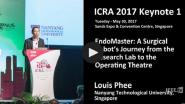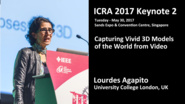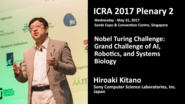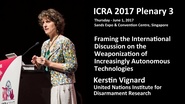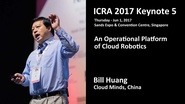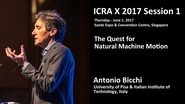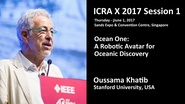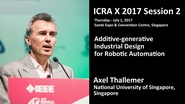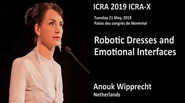
EndoMaster: A Surgical Robot's Journey from the Research Lab to the Operating Theatre
Louis Phee, Nanyang Technological University, Singapore
EndoMaster: A Surgical Robot’s Journey from the Research Lab to the Operating Theatre?
I will share my experiences in developing a novel flexible robotic system that removes gastric and colon tumours using natural orifices as points of access. I will discuss the technical and medical challenges faced to push the research to successfully test the robot on human subjects. Thereafter, a company (EndoMaster) was incorporated to commercialise the product. The challenges faced in the translation of the robotic technology to be used in a clinical setting were entirely different from the research phase. By sharing my experiences, I hope to inspire more researchers to translate their research and inventions to actual useful products.
Capturing Vivid 3D Models of the World from Video
Lourdes Agapito, University College London, UK
Capturing Vivid 3D Models of the World from Video
As humans we take the ability to perceive the dynamic world around us in three dimensions for granted. From an early age we can grasp an object by adapting our fingers to its 3D shape; we can understand our mother’s feelings by interpreting her facial expressions; or we can effortlessly navigate through a busy street. All of these tasks require some internal 3D representation of shape, deformations and motion.
Nobel Turing Challenge: Grand Challenge of AI, Robotics, and Systems Biology?
Nobel Turing Challenge: Grand Challenge of AI, Robotics, and Systems Biology
Nobel Turing Challenge is one of the ultimate challenges the scientific community can tackle. It aims at (1) developing AI system including substantial robotics components that can make major scientific discoveries some of which worth Nobel Prize (called as “Scientific Discovery Challenge”), and (2) actually win the prize without the selection committee noticed that it is actually an AI system, not a human researcher (Cybernetic Personality Challenge). Primary focus on this challenge will be biomedical science area for Physiology and Medicine Award (Kitano, H., AI Magazine, 37(1) 2016).
Framing the International Discussion on the Weaponization of Increasingly Autonomous Technologies
Kerstin Vignard, United Nations Institute for Disarmament Research
Framing the International Discussion on the Weaponization of Increasingly Autonomous Technologies
There are a multitude of positive military applications for increasingly autonomous technologies. However, their potential weaponization raises a host of legal, technical, operational and ethical questions. Since 2013, member states of the United Nations have been discussing the weaponization of increasingly autonomous technologies (Lethal Autonomous Robots, Lethal Autonomous Weapon Systems, or so-called “killer robots”) in both human rights and arms control fora. Four years in, there is still great division on definitions, how to ensure human control over these future weapon systems, and the appropriate policy responses.
An Operational Platform of Cloud Robotics
Bill Huang, Cloud Minds, China
An Operational Platform of Cloud Robotics
Cloud Robotics is a kind of robot whose “brains” are on cloud, with a global high-speed backbone network as the “nerve”. In the near future, all the intelligent robots will be Cloud Robotics. At this session, we will introduce the architecture of Cloud Robotics, and how to build an operational platform for millions of robots with human assistant robot intelligence, mobile intranet cloud services, and robot control units.
Model-based Optimization for Humanoid and Wearable Robots?
Katja Mombaur, University of Heidelberg, Germany
Model-based Optimization for Humanoid and Wearable Robots?
In this talk, I give an overview of our research on motion optimization for humanoid and wearable robots. On the one hand, we are interested to improve the walking capabilities of humanoid robots in different terrains. Optimization based on realistic mechanical models of the robots is a very helpful tool since it can generate motions for such redundant, underactuated systems with multiple degrees of freedom and changing contacts that are feasible, stable and optimal. Optimization can also be applied to compliant robots.
The Quest for Natural Machine Motion
Antonio Bicchi (University of Pisa & Italian Institute of Technology, Italy)
The Quest for Natural Machine Motion
We do not know how robots of the future will look like, but both the layman and the expert agree that they will not be like the heavy, rigid machines we have seen moving clumsily and somewhat menacingly in the past. Many researchers are indeed focusing on how to build softer robots which can move naturally around in an environment shared with humans.
Driving Toward Tomorrow
Emilio Frazzoli (Massachusetts Institute of Technology (MIT), USA & Singapore-MIT Alliance for Research and Technology)
Driving Toward Tomorrow
How is technology going to change mobility in the future? How will our lives and our cities change as autonomous cars become a reality? In this talk, I will explain the vision that is being pursued by nuTonomy for a future in which safe, reliable, and affordable mobility is provided to all through a fleet of autonomous shared vehicles, augmenting and complementing other transportation options.
Ocean One: A Robotic Avatar for Oceanic Discovery?
Oussama Khatib (Stanford University, USA)
Ocean One: A Robotic Avatar for Oceanic Discovery?
The promise of oceanic discovery has intrigued scientists and explorers for centuries, whether to study underwater ecology and climate change, or to uncover natural resources and historic secrets buried deep at archaeological sites. A robotic avatar could go where humans cannot, while embodying human intelligence and intentions through immersive interfaces. In collaboration with KAUST, MEKA Robotics, we developed Ocean One, a bimanual force-controlled humanoid robot. With the support of French Ministry of Culture’s Underwater Archaeology Research Department, we deployed Ocean One in an expedition in the Mediterranean to Louis XIV’s flagship Lune, lying off the coast of Toulon at ninety-one meters. In the spring of 2016, Ocean One became the first robotic avatar to embody a human’s presence at the seabed. We foresee that robotic avatars will search for and acquire materials, support equipment, build infrastructure, and perform disaster prevention and recovery operations — be it deep in oceans and mines, at mountain tops, or in space.
Challenges for Deep Learning Towards AI
RAS ICRA Conference Video
Essential Ingredients of Building a Successful Robotic Startup
Zexiang Li (Hong Kong University of Science and Technology, Hong Kong)
Essential Ingredients of Building a Successful Robotic Startup??
Though the robotics market is estimated to grow at double digits till 2022, and over USD100 million was raised by robotic startups in January 2017, our study reveals that less than 5% of robotic startups last longer than 4 years, and the number is much lower for startups whose primary founders came directly from academia. The major cause leading to the closure of robotic startups is that startups failed to deliver their products to the market in a progressive and constructive manner before using up the resources, especially the monetary investment.
Additive-generative Industrial Design for Robotic Automation
Axel Thallemer (National University of Singapore, Singapore)
Additive-generative Industrial Design for Robotic Automation
Teaching by research and tutoring Bachelor, Master and Ph.D. students of Industrial Design focusing on low-cost/low-tech robotics with the emphasis on simplicity by smart mechanics powered by artificial muscles co-developed by the speaker for Festo. For both innovation and strategic design management education is shown via case studies how to teach through research in a multidisciplinary manner. Blurring boundaries of professional compartmentalisation and contrary to fragmentation of knowledge are leading towards a new era of innovation by not mimicking nature. Visualisations clearly depict the design process, the managing of both the conceptual development and the alternative morphologies resulting in the final prototypes in comparison to the common industrial solutions. In the presented project this method is being illustrated via pneumatic gripper systems. Three bio-mimetically induced end effectors are designed and protoyped by additive-generative fabrication. Subsequently it is shown, that these three grippers may not be manufactured by traditional production methods.
Modeling the possibilities: From the Chalkboard to the Race Track to the World Beyond
Chris Gerdes, Stanford University, USA
Modeling the possibilities: From the Chalkboard to the Race Track to the World Beyond
Simple mathematical models of physical systems give us tremendous insight into the nature of their underlying dynamics and the control challenges they present. Stripping away unnecessary details can illuminate fundamental dependencies and focus engineering efforts on the most critical problems. The challenge comes when models become so familiar that they are no longer taken as simplifications but mistaken for reality itself. Opportunities and possibilities that lie outside the bounds of those simple models are subsequently missed.
 Cart
Cart Create Account
Create Account Sign In
Sign In
